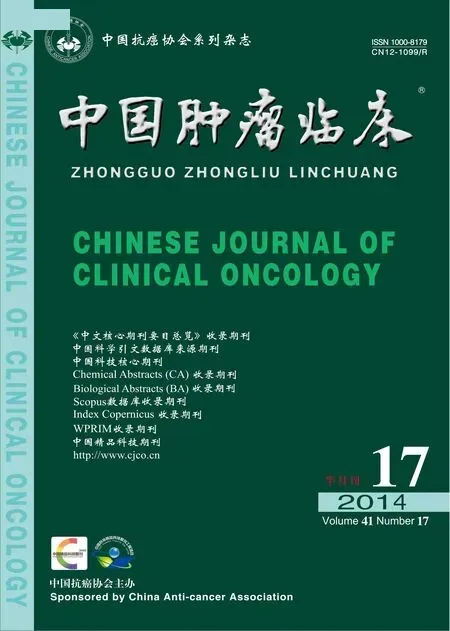mTOR抑制剂放疗增敏的研究进展*
2014-06-28刘宁波赵路军
李 雪 刘宁波 赵路军 王 平
mTOR抑制剂放疗增敏的研究进展*
李 雪 刘宁波 赵路军 王 平
放疗是肿瘤的重要治疗手段之一,仍有部分患者在接受放疗后存在复发或抗拒。哺乳动物雷帕霉素靶蛋白(mammalian target of rapamycin,mTOR)是PI3K/AKT信号通路的主要效应分子,分为mTORC1和mTORC2,对细胞生长及增殖、细胞周期进展及蛋白翻译等均有重要调节作用。mTOR异常表达与肿瘤发生及治疗反应密切相关。肿瘤的放疗敏感性与“4R”效应有关。mTOR抑制剂可通过影响细胞周期进展、DNA损伤修复及抗血管形成等多种途径发挥放疗增敏作用。初期研究证实依维莫司具有放疗增敏作用并且毒性可耐受。应用mTOR抑制剂后不同细胞及个体反应不同,可能与基因表达状态有关,需进一步研究证实。
放射治疗 mTOR 放疗敏感性 mTOR抑制剂
放疗是肿瘤的重要治疗手段之一,在实体肿瘤患者中,约一半患者在其病程中需接受放疗。与手术及化疗比较,放疗在控制肿瘤的同时可更好地保护正常组织,对全身影响更少[1]。然而,仍有部分患者在接受放疗后出现复发转移。目前,主要通过同步化疗或热疗提高放疗疗效,但效果仍不明显,且毒性增加。然而放疗结合靶向治疗效果仍不明确。mTOR是目前的研究热点和难点,与肿瘤发生、发展、转移、复发及治疗抗拒均有关[2]。但与放疗敏感性的关系仍不明确。本研究对其临床及亚临床研究现状进行综述。
1 mTOR信号通路及其抑制剂
在人类多种肿瘤中均发现PI3K/AKT信号通路的过度激活[3-5],其主要效应分子哺乳动物雷帕霉素靶蛋白(mammalian target of rapamycin,mTOR)是一种丝/苏氨酸蛋白激酶,对细胞生长及增殖、细胞周期进展及蛋白翻译等均有重要调节作用[6-8]。mTOR分为两种结构上及功能上不同的多蛋白复合物,即mTORC1和mTORC2,两种蛋白在分子组成、下游效应分子及生物效应等方面均不同[7,9-11]。mTORC1由Raptor、mLST8及mTOR组成,mTORC2由Rictor、mSIN1、mLST8及mTOR组成。mTORC1的下游效应分子主要为4E-BP1(4E-binding protein 1)及S6K1(ribosomal S6 kinase 1),而mTORC2活性与AKT Ser 473位点磷酸化有关。mTOR异常表达可通过改变蛋白合成、异常调节细胞周期及抑制细胞凋亡等途径促进肿瘤的发生发展[12]。目前认为,mTOR异常表达与放疗诱导的放疗抗拒有关[12]。放疗可通过激发生长因子受体等导致PI3K/AKT/mTOR信号通路短暂迅速激活,mTOR活化可通过多种途径减少肿瘤细胞损伤、维持细胞存活[12,13],包括磷酸化4E-BP1诱导TLK1B表达,TLK1B可促进DNA损伤修复;促使HIF-1α积聚,HIF-1α可通过诱导VEGF产生、血管形成、保护血管内皮细胞免受放疗的细胞毒性。在多种肿瘤细胞发现mTOR抑制剂有较强的抗肿瘤活性[14-17]。mTOR抑制剂主要分为两类:1)雷帕霉素及其衍生物:雷帕霉素、依维莫司RAD001、坦西莫司CCI-779和AP23573;2)mTOR激酶抑制剂:是一类小分子ATP类似物,与ATP竞争mTOR的催化靶位,从而抑制mTOR的催化活性。
2 mTOR抑制剂与放疗敏感性
放疗作用的关键靶点是DNA,可直接损伤DNA或通过活化氧化物间接损伤DNA。正常组织较肿瘤组织增殖慢,从而能有效的修复DNA损伤避免死亡[19]。分次放疗的放射生物学基础是“4R”效应,放疗导致的放疗间歇期肿瘤细胞再氧合(Reoxygenation)和细胞周期再分布(Redistribution)可增加对下一次分割照射的敏感性,但同时也能允许存活肿瘤细胞增殖(Regeneration)导致加速的再群体化(Repopulation)。肿瘤的放疗抗拒与肿瘤组织的异质性及放疗诱导的细胞基因表达和信号通路改变有关[2]。阻断AKT/ mTOR信号通路可通过影响包括“4R”效应在内的多种途径发挥放疗增敏作用[13,19]。
2.1 改变细胞周期
细胞接受放射线照射后4~12 h,细胞周期短暂停滞于G1、S、G2期,G2/M期延长,利于损伤DNA修复。通常,G1、S期细胞放疗抗拒,G2、M期细胞放疗敏感。多项研究表明,mTOR抑制剂可影响放疗后细胞周期改变[20]。Yu等[20]发现在口腔鳞癌细胞中依维莫司可通过诱导G2/M期停滞发挥放疗增敏作用。而雷帕霉素预处理A459肺癌细胞系,在放疗后8 h发现G2/M期停滞消失[22]。上述研究表明,mTOR抑制剂可通过诱导G2/M期停滞发挥放疗增敏作用,其细胞周期调控功能受作用时间及细胞种类的影响。
2.2 修复DNA损伤
射线照射所引起的DNA损伤包括DNA单链断裂(single strain break,SSB)和双链断裂(double strain break,DSB),DSB可由两种方式修复,其中同源重组修复(homologous recombination,HR)约占20%,主要在S期晚期及G2期进行;大部分DSB的修复是由非同源重组末端连接(Non-homologous end joinin,NHEJ)方式通过DNA-PKcs(DNA-dependent protein kinase catalytic subunit)完成,可在整个细胞周期进行。ATM(mutated in ataxia-telangiectasia)可检测DSB存在,ATM活化后,一方面可激活DNA-PKcs促进DSB修复,另一方面磷酸化组蛋白H2AX提高核蛋白γH2AX foci表达,γH2AX foci可反映DSB的存在。PI3K/AKT信号通过调控DNA-PKcs进一步参与DNA修复过程。研究表明,雷帕霉素和放疗处理SKBR3细胞系可明显延长γH2AX foci持续时间[21];在接受放疗的MCF-7细胞系,雷帕霉素可明显延长γH2AX foci表达时间并且增加放疗诱导的染色体损伤,抑制HR-及NHEJ-介导的DSB修复[22]。然而,另一项研究表明HeLa细胞系雷帕霉素可促进放疗诱导的DSB修复,抑制mTOR可增强放疗诱导的细胞损伤修复,抑制放疗敏感性[23]。上述研究表明,mTOR抑制剂对DNA损伤修复的不同影响与细胞种类有关。
2.3 诱导细胞死亡
DNA损伤无法修复的细胞进入程序性细胞死亡,包括凋亡(apoptosis)、自噬及坏死(autophagy and necrosis)、有丝分裂灾变(mitotic catastrophe)及加速老化(accelerated senescence)等。放疗可诱导细胞凋亡及自噬反应,通常肿瘤细胞对凋亡抗拒;目前认为[6],单纯放疗诱导的自噬反应有细胞保护作用,而放疗与雷帕霉素结合应用诱导的凋亡能增强放疗的细胞毒性。雷帕霉素与放疗结合应用,在某些细胞系中通过凋亡或自噬诱导细胞死亡,而在有些细胞系凋亡和自噬同时发挥作用。
2.4 改善组织缺氧
肿瘤血管结构异常及血流不均一导致肿瘤组织中存在缺氧区,缺氧的组织通常放疗抗拒[24]。mTOR抑制剂可通过多种途径改善组织缺氧,包括正常化肿瘤血管[25]及降低线粒体耗氧量进而改善组织缺氧[26]等,此外,Kuwahara等[18]报道依维莫司作用靶点为血管内皮细胞,可通过阻断VEGF介导的血管内皮细胞增殖及抑制肿瘤细胞释放VEGF发挥抗血管形成作用,进而改善组织缺氧。
目前,依维莫司已被美国FDA批准用于肾癌的治疗,其毒性可耐受,2/3级毒性包括高血糖症(17%)、低磷血症(13%)、贫血(9%)及高脂血症(6%)。然而,作为放疗增敏剂的研究仍处初期阶段。依维莫司可通过抑制细胞增殖、诱导细胞凋亡及细胞自噬、抗血管形成等途径增强放疗敏感性,此外依维莫司可促进肿瘤组织微血管血栓形成导致肿瘤坏死。一项Ⅰ期临床研究[28]包括10例NSCLC患者,均接受胸部放疗(35 Gy/15 f)同步依维莫司每周1次治疗。结果8例可评估,依维莫司同步放疗最大可耐受剂量为15 mg周方案,其剂量限制性毒性包括肺炎及肺出血。上述研究表明,mTOR抑制剂可用于抗肿瘤治疗,并且有望用于放疗增敏治疗,目前尚未发现不可耐受的毒性反应。
3 结语
mTOR抑制剂可通过影响细胞周期进展、DNA损伤修复及改善组织缺氧等多种途径发挥放疗增敏作用。依维莫司已批准用于抗肿瘤治疗,然而其放疗增敏作用的研究仍处于初期阶段,需进一步临床研究证实其有效性及安全性。此外,研究表明不同细胞系对mTOR抑制剂治疗反应的差异可能与基因表达状态有关,需进一步研究明确基因表达状态与mTOR抑制剂治疗反应间的关系。
1 Bernier J,Bentzen SM,Vermorken JB.Molecular therapy in head and neck oncology[J].Nat Rev Clin Oncol,2009,6(5):266-277.
2 Liu NB,Wang P.Development of PI3K/AKT/mTOR signaling pathway and hypofractionated radiotherapy in non-small cell lung cancer[J].Chin J Clin Oncol,2013(19)1196-1198.[刘宁波,王 平.非小细胞肺癌大分割放疗敏感性与PI3K/AKT/mTOR信号通路研究进展[J].中国肿瘤临床,2013(19):1196-1198.]
3 Fruman DA,Rommel C.PI3K and cancer:lessons,challenges and opportunities[J].Nat Rev Drug Discov,2014,13(2):140-156.
4 Rodon J,Dienstmann R,Serra V,et al.Development of PI3K inhibitors:lessons learned from early clinical trials[J].Nat Rev Clin Oncol,2013,10(3):143-153.
5 Vanhaesebroeck B,Stephens L,Hawkins P.PI3K signalling:the path to discovery and understanding[J].Nat Rev Mol Cell Biol, 2012,13(3):195-203.
6 Dumont F J,Bischoff P.Disrupting the mTOR signaling network as a potential strategy for the enhancement of cancer radiotherapy[J]. Curr Cancer Drug Targets,2012,12(8):899-924.
7 Laplante M,Sabatini DM.mTOR signaling in growth control and disease[J].Cell,2012,149(2):274-293.
8 Efeyan A,Sabatini DM.mTOR and cancer:many loops in one pathway[J].Curr Opin Cell Biol,2010,22(2):169-176.
9 Shimobayashi M,Hall MN.Making new contacts:the mTOR network in metabolism and signalling crosstalk[J].Nat Rev Mol Cell Biol,2014,15(3):155-162.
10 Sun SY.mTOR kinase inhibitors as potential cancer therapeutic drugs[J].Cancer Lett,2013,340(1):1-8.
11 Gomez-Pinillos A,Ferrari AC.mTOR signaling pathway and mTOR inhibitors in cancer therapy[J].Hematol Oncol Clin North Am,2012, 26(3):483-505.
12 Burris HR.Overcoming acquired resistance to anticancer therapy:focus on the PI3K/AKT/mTOR pathway[J].Cancer Chemother Pharmacol,2013,71(4):829-842.
13 Dumont FJ,Bischoff P.Disrupting the mTOR signaling network as a potential strategy for the enhancement of cancer radiotherapy[J]. Curr Cancer Drug Targets,2012,12(8):899-924.
14 Yamashita AS,Baia GS,Ho JS,et al.Preclinical evaluation of the combination of mTOR and proteasome inhibitors with radiotherapy in malignant peripheral nerve sheath tumors[J].J Neurooncol, 2014,118(1):83-92.
15 Briest F,Grabowski P.PI3K-AKT-mTOR-signaling and beyond:the complex network in gastroenteropancreatic neuroendocrine neoplasms[J].Theranostics,2014,4(4):336-365.
16 Chen WX,Zheng SZ,Wang AY,et al.Feedback Activation Mechanism of mTOR Pathway and Antitumor Application of Its Inhibitors[J].Chin J Clin Oncol,2011(24):1597-1599.[陈文星,郑仕中,王爱云,等.mTOR的反馈激活机制及其抑制剂的抗肿瘤应用[J].中国肿瘤临床,2011(24):1597-1599.]
17 Jia XQ,Liu GY.Advancements in mTOR inhibitors for the management of hormone receptor-positive breast cancer[J].Chin J Clin Oncol,2013(22):1408-1411.[贾晓青,柳光宇.mTOR抑制剂在激素受体阳性乳腺癌治疗中的研究进展[J].中国肿瘤临床,2013(22):1408-1411.]
18 Kuwahara Y,Mori M,Kitahara S,et al.Targeting of tumor endothelial cells combining 2 Gy/day of X-ray with Everolimus is the effective modality for overcoming clinically relevant radioresistant tumors[J].Cancer Med,2014,3(2):310-321.
19 Karar J,Maity A.PI3K/AKT/mTOR Pathway in Angiogenesis[J]. Front Mol Neurosci,2011,4:51.
20 Yu CC,Hung SK,Liao HF,et al.RAD001 Enhances the Radiosensitivity of SCC4 Oral Cancer Cells by Inducing Cell Cycle Arrest at the G2/M Checkpoint[J].Anticancer Res,2014,34(6):2927-2935.
21 Choi EJ,Ryu YK,Kim SY,et al.Targeting epidermal growth factor receptor-associated signaling pathways in non-small cell lung cancer cells:implication in radiation response[J].Mol Cancer Res,2010, 8(7):1027-1036.
22 Chen H,Ma Z,Vanderwaal RP,et al.The mTOR inhibitor rapamycin suppresses DNA double-strand break repair[J].Radiat Res, 2011,175(2):214-224.
23 Bandhakavi S,Kim YM,Ro SH,et al.Quantitative nuclear proteomics identifies mTOR regulation of DNA damage response[J]. Mol Cell Proteomics,2010,9(2):403-414.
24 Sato Y.Persistent vascular normalization as an alternative goal of anti-angiogenic cancer therapy[J].Cancer Sci,2011,102(7):1253-1256.
25 Fokas E,Im JH,Hill S,et al.Dual inhibition of the PI3K/mTOR pathway increases tumor radiosensitivity by normalizing tumor vasculature[J].Cancer Res,2012,72(1):239-248.
26 Kelly CJ,Hussien K,Fokas E,et al.Regulation of O2 consumption by the PI3K and mTOR pathways contributes to tumor hypoxia[J]. Radiother Oncol,2014,111(1):72-80.
27 Waqar SN,Robinson C,Bradley J,et al.A Phase I Study of Temsirolimus and Thoracic Radiation in Non-Small-Cell Lung Cancer [J].Clin Lung Cancer,2013.
(2014-03-21收稿)
(2014-07-03修回)
(本文编辑:邢颖)
Research on mTOR inhibitors used in radio-sensitization
Xue LI,Ningbo LIU,Lujun ZHAO,Ping WANG
Ping WANG;E-mail:tjdoctorwang@163.com
Departments of Radiation Therapy,Tianjin Medical University Cancer Institute and Hospital,Tianjin Key Laboratory of Cancer Prevention and Therapy,National Clinical Research Center of Cancer,Tianjin 300060,China.
This work was supported by National Natural Science Foundation of China(No.81372518).
Radiotherapy is important for cancer treatment.However,some patients still experience relapse and exhibit radiation resistance.Mammalian target of rapamycin(mTOR)is the main effector molecule in PI3K/AKT signaling.This molecule is found in two structurally and functionally distinct multi-protein complexes known as the mTOR complex 1 and mTOR complex 2.The mTOR signaling pathway controls the growth,proliferation,survival,and apoptosis of cancer cells.This pathway is closely related to tumorigenesis and treatment response,and is used in sensitizing radiotherapy.mTOR inhibitors regulate radio-sensitization through multiple mechanisms,including cell cycle alterations,DNA repair modulation,and tumor hypoxia reduction.Preclinical studies showed that mTOR inhibitors with tolerable toxicity may be used as an effective modality to overcome radio-resistant tumors.Responses to mTOR inhibitors vary depending on the cell lines.Molecular markers can be used to select suitable patients.Further studies are needed to completely understand the use of mTOR inhibitors in radio-sensitization.
radiotherapy,TOR Serine-Threonine Kinases,radiosensitivity,mTOR inhibitor

10.3969/j.issn.1000-8179.20140360
天津医科大学肿瘤医院放疗科,国家肿瘤临床医学研究中心,天津市肿瘤防治重点实验室(天津市300060)
*本文课题受国家自然科学基金项目(编号:81372518)资助
王平 tjdoctorwang@163.com
李雪 在读硕士研究生。专业方向为胸部肿瘤的放射治疗。
E-mail:lixuefangliao@163.com
